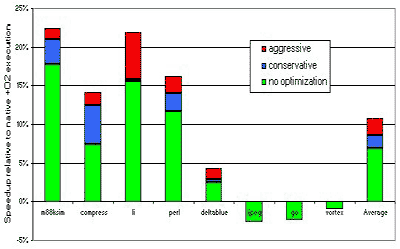KidPaddle schrijft dat HP aan technologie werkt, vergelijkbaar met de transmeta, waarmee binaries sneller uitgevoerd kunnen worden. Dit wordt in tegenstelling tot de transmeta in de software gedaan en daardoor zou deze technologie ook op onze P2,3 en Athlons toegepast kunnen worden om een de performance tot 20% omhoog te halen ![]() .
.
Dynamo is an odd beast. It is, in essence, an interpreter for HP's PA-8000 instruction set that itself runs on a PA-8000 processor. That's right -- it interprets programs that could just as easily be executed natively on the same hardware. For a research prototype, this isn't as strange as it seems. The Dynamo project was started to investigate issues in what was seen as an increasingly important area -- dynamic translation of non-native binaries to native code. For that purpose it doesn't really matter if the original binaries are non-native or not, only that, whatever they are, they're read into some internal form, munged, and spit back out for native execution. The question is only, "How can this translation be efficient, both in time and space?" What's surprising is that Dynamo "inadvertently" became practical. Programs "interpreted" by Dynamo are often faster than if they were run natively. Sometimes by 20% or more.
[...] So what's the bottom line? The following graph illustrates that "interpreting" your programs with Dynamo can provide significant performance improvements. The programs shown are part of the SPEC benchmark suite. The bars indicate Dynamo's speedup compared to binaries compiled with "+02" using HP's commercial compiler. As it turns out, HP prices their machines, in part, on the basis of their performance on these benchmarks. As a result, HP's compiler teams get big bonuses if they improve performance by even small amounts on the SPEC suite, so they spend their days trying to eke out a cycle here, a cycle there. When the Dynamo team brought their results to the compiler team it caused quite a stir.
 |
